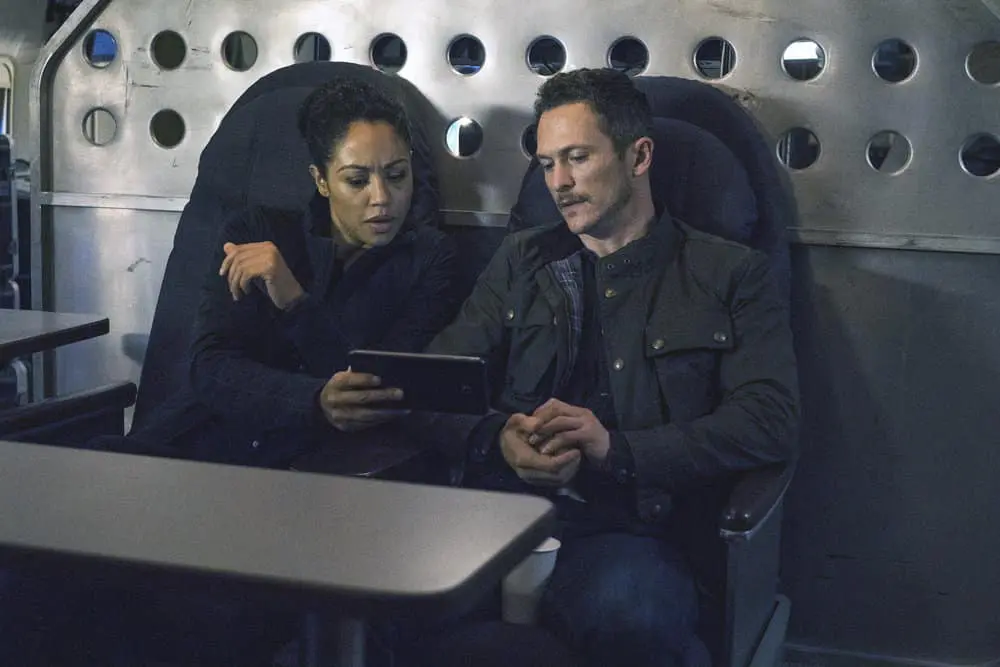Summary
“Solar Winds” continues to blend extraterrestrial weirdness with human emotion to mixed results.
This recap of Debris season 1, episode 3, “Solar Winds”, contains spoilers.
At the start of Debris episode 3, Bryan is cleared for duty despite having been cloned in the previous episode. It’s a small moment, a quick nod in the direction of continuity, but it’s symbolic of the entirety of “Solar Winds”, really — business as usual, with little thought spared for how convenient everything is.
This isn’t so much of a bad thing. Nobody is more insufferable than the ardent nitpickers who want to know who fuels up the Batmobile or whatever. But if there’s a word to describe “Solar Winds”, and indeed both prior episodes of Debris, it’s “convenience.” Extra-terrestrial pickles are arrived at in every episode and solved just as quickly, usually thanks to some relevant insider knowledge or handily-placed McGuffins (the concept of the debris is, in general, a narrative cheat code, never more evident than here.) It keeps things pacey but also prevents the human drama from taking root. The show is very obviously pushing the idea of the alien debris proving that human emotions and connections are real, tangible things with observable material properties, but the ways in which that idea is put across always feel a bit contrived.
Debris season 1, episode 3 sends Bryan and Finola to Ohio, to a cell tower where a mysterious, hazy square has appeared quite randomly. There are shadowy figures visible beyond, quite obviously trying to break free, but they seem unable to. Bryan and Finola, with help from a tech guy called Muntz, figure out almost immediately that there are sounds of communication only audible on a video recording. When the square returns, some headphones allow Finola to communicate with the woman on the other side, who says her name is Nicole and turns out to be a missing person.
Incredibly conveniently, Finola’s father believed in a theory of “curled up dimensions”, access points just waiting for us to develop the means to use them. But access points to what? Well, one assumes several other dimensions, and one also assumes that the debris is functioning as a kind of key to these access points. Finola shows Bryan footage of a lecture during which her father explains this, and he also created a map of the access points, one of which was right in this field. See what I mean about convenience?
It’s even convenient on an emotional level since Finola gets upset at seeing the video because it reminds her of how much she misses her presumed-dead father. Bryan knows there’s much more to the fate of George Jones than she realizes, which is why he expresses to Maddox earlier in “Solar Winds” that he’s worried MI6 will pull her from the team if they figure out the CIA is in possession of Jones’s body. You get the sense he’s trying to avoid the inevitable awkward conversation they’ll be forced to have when she realizes how much he has been keeping from her. It’s a bit of a ham-fisted way of reiterating the dynamic that Bryan is emotionally cold and closed-off, while Finola still sees the magic in the world and believes in the strength of human connection. There’s nothing wrong with that as a theme, but there is with the clumsy way that Debris episode 3 explores it.
I must admit, though, that as a father to two girls, “Solar Winds” moved me a little. Muntz suggests maintaining sustained contact with Nicole so that he can determine what she’s seeing from her side of the square, and the best way to do that is to bring her father in. He’s still devastated at the loss of his daughter and has been having vivid, recurring dreams about reuniting with her, which leads Finola to posit the idea that human bonds might be an unseen force, like gravity, which is the kind of thing that the show obviously can’t help but get behind. The episode’s premise might resemble Arrival somewhat, but its heart is more reminiscent of the third act of Interstellar when Christopher Nolan imagined a father’s love as a force powerful enough to save the world.
With help from her father, Nicole is able to communicate again, revealing that she isn’t privy to the other figures who’re visibly trapped there with her and that she believes she has only been missing for a few hours. The square promptly disappears again, and Muntz can’t determine anything concrete without the debris itself, which makes it very fortuitous that the team stumbles across it in the very next scene. It appears that Influx agents have gotten there first, but the two teams can’t see one another despite obviously occupying the same location. I honestly can’t tell whether this was to make a point about them being in separate dimensions or “Solar Winds” being too cute with its editing. Either way, the team has access to the debris, which is still trying to function with its remaining power. Muntz wants to preserve that power so the debris can be properly examined rather than splurge it rescuing people, but Finola gives him a big idealistic speech and he immediately relents, which seems like a missed opportunity to actually unpack competing viewpoints in this universe. But no matter.
With help from the debris the team is able to bring the square back, and using another piece of debris they’re able to open it for long enough to drag Nicole free, along with several other people who were trapped with her, all of whom believe they’re still in the ’80s, or the ’70s, or whatever other decade they disappeared from. The implication, I think, is that all these missing people fell into the dimensional access points described by George and have been left idling ever since until the debris allowed those access points to be opened. From behind glass, Nicole describes the dream that kept her going — the exact same one her father had, time and time again.
It’s cute, as endings go, though Debris season 1, episode 3 closes with a more sinister development. After almost getting himself into a spot of bother trying to sneakily negotiate the exchange of a piece of debris important to the Russians with a bloke named Tarkolov, Maddox is called about George Jones’s body. Except, it isn’t his body. In some CCTV footage, we see Finola stood by her father’s corpse in the morgue, taking his watch as presumably a keepsake. Then a big chunk of time is lost from the recording, and when we see the body being put away, the watch is present again — whoever stole and replaced Jones’s body with a decoy didn’t realize the watch had been taken. So where’s the real George Jones?




